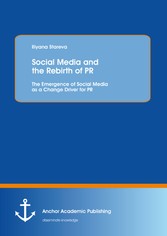Suchen und Finden
Mehr zum Inhalt

Social Media and the Rebirth of PR: The Emergence of Social Media as a Change Driver for PR - The Emergence of Social Media as a Change Driver for PR
Text Sample: Chapter, 2.1.1. What is PR?: As a discipline, PR dates back to the beginning of the 20th century and is strongly linked to the growth of the media (print, TV, radio, online) when it begins to influence actions, behaviour and policy (Butterick, 2011). In 1982 the Public Relations Society of America (PRSA, 2012) adopted the following definition: Public Relations helps an organization and its publics adapt mutually to each other. Grunig and Hunt (1984: 8) similarly describe PR as 'the management of communications between an organisation and its publics.' The Chartered Institute of Public Relations (CIPR, 2012) offers another definition: Public relations is about reputation - the result of what you do, what you say and what others say about you... It is the planned and sustained effort to establish and maintain goodwill and mutual understanding between an organisation and its publics. PRSA's definition has a strong implication on the importance of a dialogue, whereas the CIPR puts emphasis on reputation by building and fostering good relationships with various publics. Henslowe (2003) also highlights that PR is about establishing and maintaining a sound two-way communication between an organisation and everyone with whom it has any form of contact. There are many more definitions of PR. The reason for this is that the industry itself is always changing and adapting to the world and growing power of the media, old and new (Gordon, 2011). However, most of them define it as a discipline that is concerned with the exchange of information (Phillips and Young, 2009) and as a strategic management function that seeks to build relationships with the various publics of an organisation by maintaining a meaningful two-way communication with them. It therefore should be an essential part of the organisational structure that can be truly effective when integrated into the broader business disciplines such as corporate planning, finance, HR etc. (Smith and Zook, 2011).
Alle Preise verstehen sich inklusive der gesetzlichen MwSt.







